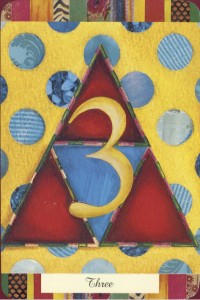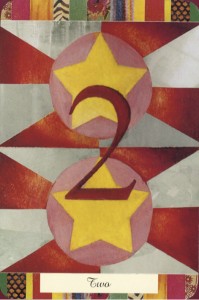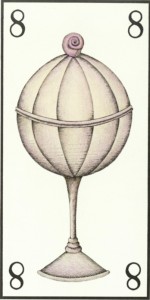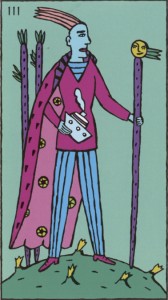Wise Livelihood
 The fifth factor of the Noble Eightfold Path is samma ajivo, translated as Wise (or Right) Livelihood. This means not earning one’s living in ways that bring harm to oneself or others, particularly if it involves killing.
The fifth factor of the Noble Eightfold Path is samma ajivo, translated as Wise (or Right) Livelihood. This means not earning one’s living in ways that bring harm to oneself or others, particularly if it involves killing.
Here’s what Phillip Moffitt has to say in Dancing with Life:
“To me, it also means not having a violent attitude in whatever you do for a living….In our time, it is not usually the profession but rather the manner in which the profession is practiced that causes wrong livelihood. For example, if you recklessly drive your car while commuting to work, or prey on the ignorance of others, or mislead or trick others in order to earn a living, you are practicing wrong livelihood.
“In my view, any job that takes away joy, whether your own or others’, also constitutes unwise livelihood, whereas any job that supports and nourishes well-being and the sense of the possibility is wise livelihood.
“Wise livelihood matters as a practice because it brings freedom to the mind now and in the future, while unwise livelihood thrusts the mind into turmoil now and plants the seed for even greater turmoil in the future.”
**
I’m retiring at the end of the month, but that doesn’t mean I’m off the hook in terms of Right Livelihood. The Pail word ajivo, which is translated here as “livelihood,” actually means something closer to “fuel for the fire of living.” So it’s not just about what one does to bring in money but, more deeply, what one does to sustain oneself. After I retire, I’ll use savings and investments to buy things and to pay my bills. But what will I do to sustain the fire of my life?
Dharma Town!
Next Up: Wise Effort
Wise Action
 The fourth factor of the Noble Eightfold Path is samma kammanta, translated as Wise (or Right) Action. Traditionally, Right Action is taught as not indulging in bodily actions that cause harm to oneself or others, specifically: not killing, not stealing and not engaging in sexual misconduct. These are the first 3 of the 5 Training Precepts. The 4th is to refrain from actions of speech that cause harm, specifically: not lying. (The 5th is to refrain from using intoxicants that cloud the mind….and make it much less likely that you will adhere to the first four!)
The fourth factor of the Noble Eightfold Path is samma kammanta, translated as Wise (or Right) Action. Traditionally, Right Action is taught as not indulging in bodily actions that cause harm to oneself or others, specifically: not killing, not stealing and not engaging in sexual misconduct. These are the first 3 of the 5 Training Precepts. The 4th is to refrain from actions of speech that cause harm, specifically: not lying. (The 5th is to refrain from using intoxicants that cloud the mind….and make it much less likely that you will adhere to the first four!)
Here’s what Phillip Moffitt writes in Dancing with Life:
“Wise action is any action that liberates the mind, moves you toward freedom from suffering, and supports a feeling of well-being that is independent of external conditions. It arises out of clear comprehension (sampajanna), meaning you are clear about what is needed, what is appropriate, and what is doable within your limits. In order to take action with such clarity, you approach decisions with mindfulness and with awareness of the dharma.
“Wise action doesn’t just apply to big decision, but applies to small ones as well. You see the truth of suffering and impermanence and that your immediate situation is caused by impersonal causes and conditions, and this larger dharma view allows right action to unfold. You cultivate being mindful of all your actions, even those that you don’t ordinarily notice, such as how fast you walk, how you sit at your desk, how you decide what to eat, and how fast you eat it. Wise action is reflected in how you schedule and pace yourself, how you treat others, and how you nourish yourself.”
Wow. I don’t know about you, but that last one really hit home.
Up next: Right Livelihood
Wise Speech
 The third factor of the Noble Eightfold Path is samma vaca, translated as Wise (or Right) Speech. Traditionally, right speech means not speaking falsely, harshly, divisively or engaging in idle chatter.
The third factor of the Noble Eightfold Path is samma vaca, translated as Wise (or Right) Speech. Traditionally, right speech means not speaking falsely, harshly, divisively or engaging in idle chatter.
In Dancing with Life, Phillip Moffitt writes:
“The practice of right speech is built around meeting three conditions simultaneously: Say only what is true and useful and timely. If any one of these criteria isn’t met, then silence is the wise form of speech.”
From personal experience, I have to admit that this is a lot harder than it sounds.
Phillip says, “You may not realize the aggressive nature of your speech until you try to make it a mindfulness practice… For instance, you may feel that if you know something is true, then it is okay to speak it. But the Buddha was quite explicit in saying that when truth is spoken in an untimely manner, it is not wise speech…..Applying the filter of saying only what is useful is even harder…. Practicing right speech includes actively refraining from giving unsolicited opinions or stating your view when it serves no purpose.”
Gosh.
“At first practicing right speech can seem like expecting perfectionism, and it certainly is true that the harm resulting from unwise speech can seem slight at times. But as many students have discovered once they have truly engaged in this practice, the cumulative effect of unwise speech is quite dramatic, although mostly unseen. It drains your energy, and it encourages you to get caught in clinging to your views, to become lost in desire, and to become more aversive, vindictive, and defensive. And it causes other to pay less attention when you speak.”
Hmmm.
Next up: Wise Action
Wise Intention
 The second factor on the Noble Eightfold Path is samma sankappa, usually translated as Wise (or Right) Intention.
The second factor on the Noble Eightfold Path is samma sankappa, usually translated as Wise (or Right) Intention.
Here’s what Phillip Moffitt has to say, in Dancing with Life:
“In Buddhist terms, practicing right or wise intention means making a commitment to not cause suffering for yourself or others, which requires renouncing those desires that would cause harm. You meet the world with compassion, loving-kindness, generosity, and integrity, and you strive diligently toward liberation. Your wise intention empowers you to align your thoughts, words, and action with your deepest understanding.
“Intention is the pivot point that allows you to dance with life. It is the bridge between understanding and action. Understanding without intention is conceptual and passive, no matter how profound it may be. Wise intention, on the other hand, has an immediate, energetic, attentive quality.
“…There is a big difference between goals and right intention. Your goals are your preferences for the future. Your goals provide inspiration and direction as well as determine how you allocate your time and resources. But your goals do not determine how you act right now. Instead, your intention determines how you actually think, act, and speak in any given moment.
“The following analogy makes clear the distinction between goals and intention. Let’s say you and a friend decide to hike up a mountain. You see the mountaintop and you know that reaching it is your goal–it provides direction and inspiration for the hike. It even informs your preparation and resource allocation–the time you need to set aside, how much water and food you will take along, how you will dress, etc. Therefore, committing to the goal is a vital part of the hike.
“But the actual experience of hiking is very different than reaching your goal, the mountaintop. Your journey up the mountain consists of a series of single steps, rest stops, moments of seeing nature, and sharing companionship. The hike happens in the present moment in each individual step, and each step is primarily defined by your intention. If all you focus on is the goal, you can easily miss being present for the hike.”
Next up: Wise Speech
Wise Understanding
 The first of the eight “folds” of the Buddha’s Eightfold Path is samma ditthi, traditionally translated as Right View or more recently, Right Understanding. But “right” can sound like a value judgment (“I’m right, you’re wrong”), when what is really meant is something closer to “wise,” or “skillful,” even “helpful” or “healthy.”
The first of the eight “folds” of the Buddha’s Eightfold Path is samma ditthi, traditionally translated as Right View or more recently, Right Understanding. But “right” can sound like a value judgment (“I’m right, you’re wrong”), when what is really meant is something closer to “wise,” or “skillful,” even “helpful” or “healthy.”
Here’s what Phillip Moffitt says about this in Dancing with Life:
“I sometimes use the phrase deep understanding instead of wise understanding to highlight the difference between ‘dharma understanding’ and ‘regular knowledge.’ Regular knowledge is surface understanding about events, which allows you to control conditions in order to fulfill your desires. In contrast, cultivating deep understanding enables you to find peace of mind in all circumstances, regardless of whether the surface conditions of your life are pleasant or unpleasant.”
When describing the Eightfold Path, Right View / Wise Understanding is normally listed first, but it’s not something you “do” or “get” and then go on to the next step. It is a way of setting off in the right/wise direction, but it’s also the result of following the Path, because doing so will naturally lead to a deeper, wiser understanding of how to live without suffering.
Here’s what Phillip has to say:
“It is taught that right view is understanding and framing your experience through the Four Noble Truths. Right view is also the understanding that your actions have consequences. Your first encounter with wise understanding may come from a personal experience of suffering so overwhelming that you realize there must be a better way to cope with life. Or it may arise out of an urgent need to find some meaning in your life that while not unhappy, seems superficial….Through wise understanding you clarify what really matters to you and formulate a set of values by which to live.
“Right view comes at the beginning of the Eightfold Path because without realizing that there is dukkha [stress, suffering, some nagging sense of dissatisfaction] in your life and understanding that you can do something about it, you would never be motivated to start. Wise Understanding is also the continuous, cumulative result of practice.
“For this reason, it is useful to think of the Eightfold Path as both a sequence of eight steps that follow one after the other and as an interconnected set of eight energetic practices that relate circularly and directly to one another, such that wherever you start on the path is beginning. Whichever aspect of the Eightfold Path you focus on, you engage all the parts directly or indirectly. And if you explore any of the eight factors in sufficient depth, it will lead you naturally to another.”
Next up: Wise Intention.
Dancing on the Eightfold Path
 The Monday night “Dancing with Life” KM Group has now started reading/discussing Chapter 20 (of Dancing with Life, by Phillip Moffitt). The chapter is titled: Developing Intention, Your Ally on the Path and it focuses on each of the 8 “factors” of the Noble Eightfold Path. Which are:
The Monday night “Dancing with Life” KM Group has now started reading/discussing Chapter 20 (of Dancing with Life, by Phillip Moffitt). The chapter is titled: Developing Intention, Your Ally on the Path and it focuses on each of the 8 “factors” of the Noble Eightfold Path. Which are:
Wise Understanding
Wise Intention
Wise Speech
Wise Action
Wise Livelihood
Wise Effort
Wise Mindfulness
Wise Concentration
Phillip writes: The Noble Eightfold Path is not a set of beliefs or laws but rather a practical, direct experience method for finding meaning and peace in your life.
Think of it as an organic blueprint from which you organize and live your life. Each of the path factors defines one aspect of behavioral development needed for you to move from suffering to joy. Its eight factors function as an integrated system or matrix that supports and informs all parts of your life.
[The Buddha said the Four Noble Truths of suffering and the end of suffering must be “penetrated to by cultivating the Path.”] By “cultivating,” the Buddha means “attending to, nourishing, and manifesting” each of these factors of wisdom in your life.
***
I’ll post what Phillip has to say on each of these factors over the next eight days. Stay tuned.
(image: Tarot Maddonni)
All Those “Others”
 I’m getting ready for a family vacation next week, in which various siblings, cousins, nieces, grandparents, in-laws, etc. will converge at the house in Wisconsin where my parents live during the summer. In honor of which, I offer these words from Training in Compassion, by Norman Fischer:
I’m getting ready for a family vacation next week, in which various siblings, cousins, nieces, grandparents, in-laws, etc. will converge at the house in Wisconsin where my parents live during the summer. In honor of which, I offer these words from Training in Compassion, by Norman Fischer:
“Dealing with others isn’t just dealing with others. We think of it that way, but that’s a mistake. Dealing with others is dealing with ourselves dealing with others. There are no others apart from us, there is no us apart from them. Our problems with others are our problems with ourselves and vice versa….
“Without our understanding that we have been doing this, we have been co-creating with others the conflicts and interpersonal hassles of our lives…
“When you keep in mind that your human life and the lives of others are rare and precious, that you and everyone else has to die someday, that no one escapes suffering, and that all of your words and deeds, and even thoughts and feelings, have big impacts on the world–when that is part of what you are aware of when you are aware of conflict with others, things change somewhat. These reflections may take the edge off your hurt or aggression and reframe for you what you are dealing with.”
Not that all family vacations are necessarily an occasion for conflict.
I’m just saying.
(image from: Steampunk Tarot)
Practicing Practice
 We had a great discussion last night in the Dancing with Life KM group, where basically we acknowledged that in moving toward a life of less suffering, we often have to experience quite a bit more of it. Here’s the passage we discussed (from page 219 of the hardback edition of Dancing with Life, by Phillip Moffitt):
We had a great discussion last night in the Dancing with Life KM group, where basically we acknowledged that in moving toward a life of less suffering, we often have to experience quite a bit more of it. Here’s the passage we discussed (from page 219 of the hardback edition of Dancing with Life, by Phillip Moffitt):
“Walking the Eightfold Path is a humbling undertaking. You will spend a lot of time on various plateaus where nothing seems to be happening in the way of less suffering or more insight.
“Sometimes, as you become more aware of your thoughts and actions, it can actually feel like you are suffering more. When you start to give up behavior that once stimulated, entertained, or distracted you, it can seem as if you’ve made the sacrifice for no good reason.
“Therefore, it is necessary that you learn to love the plateaus. I mean really love them.
“Practicing practice becomes the ground for your journey. Day after day, you find joy, or at least a sense of alignment, by simply practicing each of these eight factors as best you are able. You learn to laugh at the follies of your mind, to stop being self-judging, and to just get back on the path when you have wandered off.”
(image from: Kitty Kahane’s Tarot)
Living and Dying
from The Tibetan Book of Living and Dying, by Sogyal Rinpoche:
 “Above all, be at ease, be as natural and spacious as possible. Slip quietly out of the noose of your habitual anxious self, release all grasping, and relax into your true nature.
“Above all, be at ease, be as natural and spacious as possible. Slip quietly out of the noose of your habitual anxious self, release all grasping, and relax into your true nature.
“Think of your ordinary, emotional, thought-ridden self as a block of ice or a slab of butter left out in the sun. If you are feeling hard and cold, let this aggression melt away in the sunlight of your meditation.
“Let peace work on you and enable you to gather your scattered mind…and awaken in you the awareness and insight of Clear Seeing. You will find your negativity disarmed…and your confusion evaporating slowing like mist into the vast and stainless sky of your absolute nature.”
(image from: kidsforsavingearth.org)
Knowing That You Know
 Last night the Dharma Seed KM group listened to a wonderful talk by Phillip Moffitt called The Refuge in Awareness. In it, he discusses the subtle nature of awareness, gives very helpful directions on how to take awareness itself as an object of meditation and reflects deeply on what it means to “rest” in awareness. I highly recommend listening it. (click here)
Last night the Dharma Seed KM group listened to a wonderful talk by Phillip Moffitt called The Refuge in Awareness. In it, he discusses the subtle nature of awareness, gives very helpful directions on how to take awareness itself as an object of meditation and reflects deeply on what it means to “rest” in awareness. I highly recommend listening it. (click here)
Phillip often uses the phrase “knowing that you know” to describe this quality of awareness. In Dancing with Life, he lists three empowerments that come from this knowing:
“First, only by knowing that you know will you have a base of insight that will allow you to realize the remaining insights. Otherwise, you will get stuck in your thoughts and emotions…
“Second, by enabling you to integrate the insights into your daily existence, knowing that you know allows the dharma to make a substantial transformation in how you live your life right now….
“Finally, knowing that you know is an end in itself. Ajahn Sumedho describes this state as ‘Buddha knows the dharma,’ when your true nature is in touch with itself. The result is what I call an ’embodied presence’: You become a person who walks your talk because you’re consciously willing to bear your suffering. With the integration of each truth, your wisdom grows and this sense of embodied presence becomes stronger and stronger.”
(image from: Napo Tarot)
